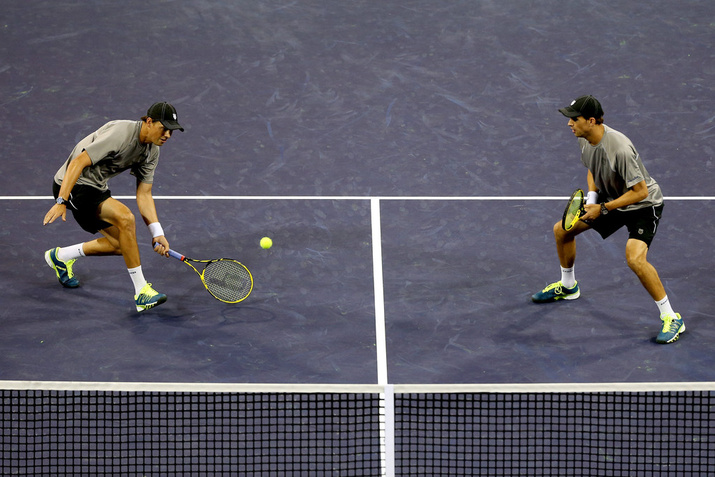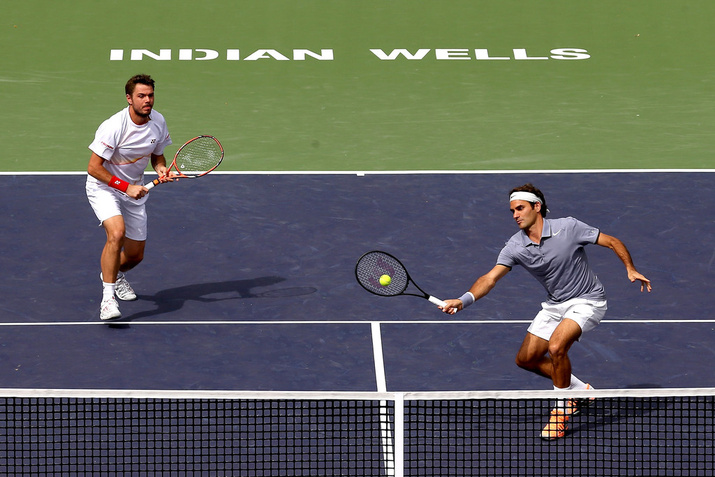Don't miss any stories → Follow Tennis View
FollowSingles Stars Seek Doubles Success at Indian Wells
Earlier in tennis history, most elite singles players held doubles competitions in a much higher regard than they do now. With singles purses continually rising and fear of injury or burnout in their minds, the majority of the elite singles players today choose to focus solely on that event while bypassing doubles. However, with an increased number of top singles competitors in the doubles draw at Indian Wells, are we witnessing a reversal in the trend?
John McEnroe, one of the all-time greats in both singles and doubles, recently stirred the pot by calling for the end of doubles at Grand Slam events. “Why we are even playing doubles at this point is a mystery to me,” said McEnroe in December. “I love doubles but I don’t even recognize what this is. They play an inch from the net. It is like wham, bam, thank you ma’am.”
The American is more than qualified to speak on the topic. Partnering Peter Fleming, McEnroe won 50 doubles titles, including four Wimbledon and three US Open doubles titles. Is his point valid, and did his statement grab the attention of today's elite singles players? The BNP Paribas Open suggests otherwise.

Bob and Mike Bryan are the gold standard of doubles teams in this era, but the American twins have found themselves in an Indian Wells draw that included a who’s who of top singles competitors: Roger Federer, Novak Djokovic, Stanislas Wawrinka, Jo-Wilfred Tsonga, Juan Martin del Potro, Andy Murray and John Isner, among others. Yet doubles specialists have held serve in their draw against this group of elite singles competitors. All four of the top doubles seeds have advanced, while only Tsonga and the tandem of Federer and Wawrinka are still playing among the top-10 players who entered the tournament.
As prize money for singles events escalates to uncharted levels, it is understandable from a financial standpoint why so many top players typically shy away from doubles to focus on singles. With injuries consistently at the forefront, moreover, investing in the tandem of doubles and singles is a reasonable burden to weigh in regards to the endurance test that a week or two of competition present. However, so many singles champions from previous eras competed in both formats, and current players benefit from unprecedented levels of conditioning and training, which mitigate the sport’s physicality.
For the marginal singles player who typically may not advance past the opening rounds, however, doubles play can certainly be a benefit. Playing in doubles maximizes court time and keeps their competitive juices flowing while allowing them to work on skills that may enhance their singles game. For many of these players, an early-round defeat finds them immediately boarding planes to the next event long before the current tournament has concluded if they are not entered into a second competition.
One contributing issue involving the state of doubles may lie in the evolution of the game, which gradually changed from serve and volley to its present state of baseline battles and power. For many of today's singles participants, playing at the net in doubles finds them as uncomfortable as a fish out of water. This underscores McEnroe'e assertion of the lack of volley fundamentals with a number of today's players, who choose to avoid approaching the net at all costs. Clearly, doubles forces these players to venture into areas of the game that lie outside of their modus operandi.
Another statement from McEnroe offers food for thought in view of what has unfolded at Indian Wells this week. “Most doubles players, I hate to say, are the slow guys who were not quick enough to play singles,” said McEnroe. The Bryan brothers have become legendary on the doubles circuit, but neither player has ever seen a singles ranking below No. 100 in their illustrious careers. This begs the question as to whether this is due to their overall tennis skill, or whether they have simply fine-tuned doubles skills to a level that most top singles players cannot easily reach. There is no easy answer here, but the issue is worth contemplating.

Whether this is an anomaly or the beginning of a doubles revival remains to be seen. Regardless, from a fan standpoint it is refreshing to see the Federer's and Djokovic's of the world competing in multiple draws. The ability to witness some of the all-time greats in any event is a shot in the arm for the sport. It certainly is a treat for fans at Indian Wells who already have a singles draw that rivals a Grand Slam.










